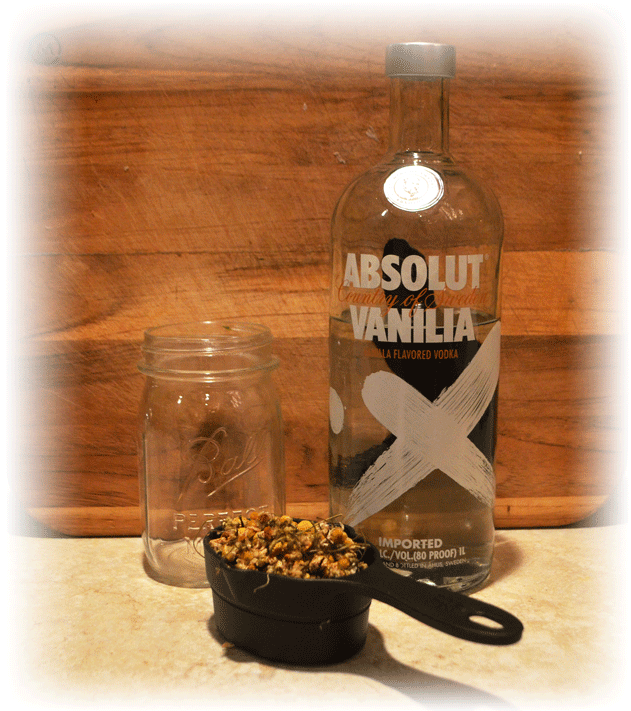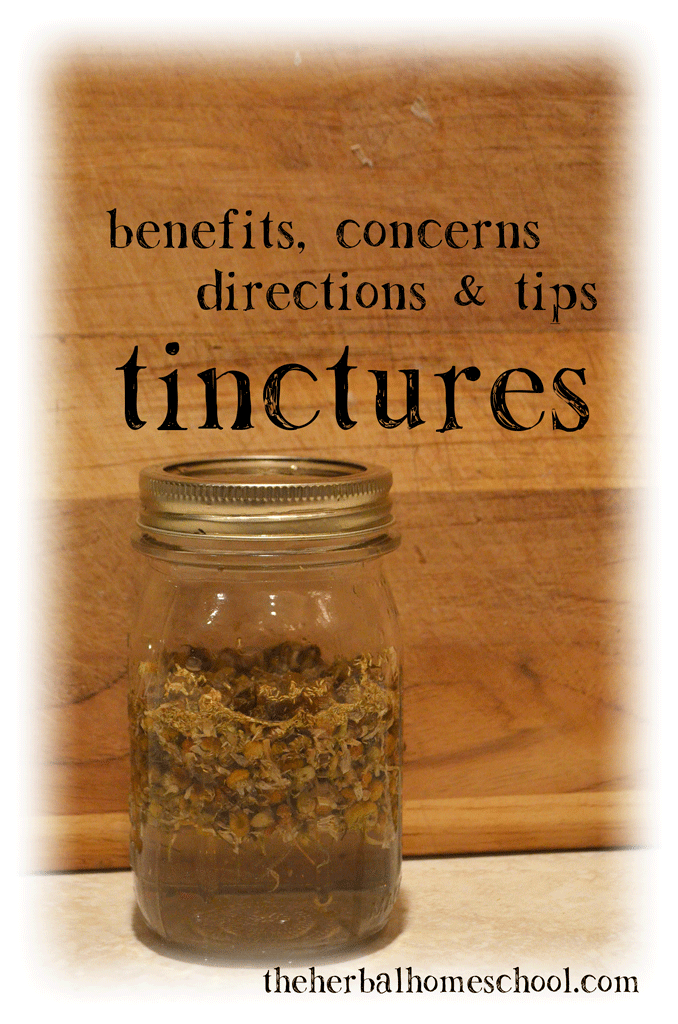Tinctures: The Basics
So what is a tincture?
The Prescription for Herbal Healing says that, “Tinctures are made by soaking an herb in alcohol. This causes the active constituents of the plant to dissolve, and gives the tincture a stronger action than teas or infusions.”
Tinctures are beneficial because they are much more concentrated, meaning it is easier to take or administer the amount of herbs you need for a treatment. For example, instead of trying to force down multiple cups of an infusion you can easily take a dropperful of tincture and carry on with your day. The downside is that you have can’t just whip up a batch of tincture like you can make a cup of tea; you have to plan ahead and wait 2-6 weeks for the alcohol to break down the plant suitably.
Technically, a tincture must have an alcohol base; anything else made with a glycerin or vinegar base is called an extract.
If you are morally opposed to the bit of alcohol in the tinctures, or are not comfortable taking them for any reason, you most definitely can substitute glycerin, which has the added benefit of being sweet without affecting blood sugar, or apple cider vinegar, which is healthy but not exactly palatable.
There are some benefits exclusively to alcohol however. According to wildernesscollege.com, alcohol will extract alkaloids, glycosides, minerals, essential oils, and other medical components that water (in an infusion) or glycerin will not. Alcohol also has the benefit of going directly into the blood stream, which obviously helps it to have a quicker affect. This is particularly helpful for treating things that need a quick response like relieving headaches or stopping bleeding. (The Herbal Apothecary)
Are Alcohol Tinctures Safe for Kids?
You may still be wondering, “Great . . . for me as an adult, but what about my toddlers or children?” I was wondering the same thing until I came across this AMAZING article on growingupherbal.com that explains perfectly why it is safe to use alcohol tinctures with your children. She explains it clearly, makes some excellent points, and will set your mind at ease without feeling pushy. She shares her reasoning based on the benefits of using an alcohol base, common foods our kids already may be eating that have notable levels of alcohol in them, just how very very very little alcohol they are actually consuming, and what a professional herbalist has to say on the subject. Basically, the gist of it is that in her mind the benefits outweigh the risks, common foods our kids go crazy about like bananas, orange juice, and fermented foods have more alcohol than a dose of tincture would, and then gives an example using the conversion formulas that shows you will find that a 70lb. 10 year old would be ingesting the equivalent of less than 1% of the maximum dosage of alcohol for his/her size when taking a dose of tincture.
If you are still concerned about the amount of alcohol in your tincture, you can evaporate much of the alcohol out by placing the dose in a hot tea and serving once it has cooled, according to growingupherbal.com
At this point my husband and I have decided that we would not give an alcohol based tincture to a baby just because it is more concentrated and we are trying to follow the principle that gentler is better for little ones. However after learning just how little the tincture dosages are for toddlers, and how to further eliminate some alcohol, we feel that we would be comfortable giving necessary amounts to our children from toddlers on up. (Especially seeing just how many bananas our daughter already eats!) Obviously this is something that you must talk over with your own family and come to your own decision that you will be comfortable acting on.
Once you have decided to go for it and lay in a supply of tinctures, what are some basic things you’ll need to know?

For anyone still wondering, the process for making a tincture is ridiculously simple. Almost as simple as taking your herbs out of storage, admiring them, and putting them back (which I have to admit to doing sometimes!)It is also not an exact science, which bothered me when I first began researching tinctures, but which I can now appreciate because of the flexibility you have in tailoring recipes to suit your needs. You will need . . .
Supplies:
-an appropriately sized glass jar (I’ve been using pint jars) and a lid,
– some 80 proof vodka,
-your herbs
– some patience.
Process:
– First you fill your mason jar up with the appropriate amount of herb, which will vary whether you are using fresh or dried herbs. See my guidelines below to help you determine how much to use (this is the “not exact science” part!)
-Next, fill the jar up to the shoulder with your 80 proof alcohol and tighten the lid on.
– Label it with what herb it is, what proportion of herb to alcohol you used, and when you started it. You may think you will remember these details, but trust me, once your pantry starts filling up with little jars of chopped weedy looking things, you will be glad you wrote down the details!
-Next find a dark place to store it for 2-6 weeks. If you remember, try to give the bottle a good shake every day to keep everything covered and well mixed. This is a good part for your kids to help with if you want to involve them!
– After 2-6 weeks, strain the tincture into a fresh container, store it away, and don’t forget about it or be afraid to use it when you need it!
Guidelines:
Alcohol: What kind of alcohol should you buy? According to Mountain Rose Herbs, 40 to 50% pure alcohol (which is the same as 80-90 proof Vodka) is standard. They say that a higher alcohol percentage is better when using more high-moisture herbs and will pull out more volatile oils. We bought 80 proof vodka to make our tinctures from. However, because he couldn’t find plain vodka, my husband bought one bottle of vanilla flavored (smells AMAZING) and one bottle of mango flavored, so our tinctures will have a little extra pizzazz to them!
If you purchase The Herbal Apothecary by JJ Pursell, she includes a great list on pages 221-224 of individual herbs and what percentage of solvent they need.
Herbs: The amount of herb you use is also obviously important; I was very pleased to find some general guidelines on Mountain Rose Herb’s website that can be applied to whichever herb you are working into a tincture.
Fresh leaves & flowers; fill the jar 2/3 to 3/4 full of chopped herbs.
Dried leaves & flowers; fill the jar 1/2 to 2/3 full of herbs.
Fresh roots, bark, and berries; fill the jar 1/3 to 2/3 full.
Dried roots, bark, and berries; only fill the jar 1/4 to 1/3 full because they will expand.
In conclusion, I’ve noted some of the benefits of tinctures, some of the possible concerns involved with using tinctures, basic guidelines for using herbs in tinctures, and the very easy process for making a tincture. So far I have made an echinacea tincture for beating colds, a chamomile tincture to help with teething, and will be making a nettle tincture to use as a tonic & replenish minerals, and give us an energy boost.
Now I want to encourage you to start thinking ahead to what health concerns your family may encounter in the future and prepare some tinctures so you are ready to meet any common health issues head on!

